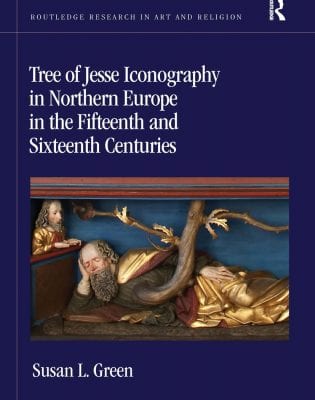In this book, Susan Green addresses the polyvalent and dynamic character of iconography, by focusing on how the depictions of the Tree of Jesse variously functioned in the late Middle Ages. According to Isaiah 11:1, a rod shall shoot from the root of Jesse and a flower shall blossom atop its branches. Since early Christianity this verse has been interpreted as a foretelling of Christ’s royal lineage. Tertullian, for instance, was quick to link the Virgin (virgo) with the rod (virga) of King David’s father, Jesse. As the author points out, the Tree of Jesse was represented in stained glass and in manuscript illuminations during the twelfth and thirteenth centuries. She suggests, however, that the subject fell out of favor during the fourteenth century, only to be revived with greater popularity in Northern Europe between 1450 and 1520. The renewed interest in the Tree of Jesse does not merely result from the growing importance of mystery plays or prophetic dramas, as Émile Mâle has argued. On the contrary, it is tied to other factors, such as the intensified fascination with St. Anne, the mother of Mary, and to theological comparisons between the Tree of Jesse and other biblical trees, including those from Eden and even the materiality of the Cross.
The first chapter reveals how representations of the Tree of Jesse in illustrated printed texts were used to encourage Marian devotion. In the Speculum humanae salvationis, a popular typological book, the Tree of Jesse was paired with the Birth of the Virgin, a juxtaposition that indicated her own royal status and her significance in the story of salvation. A similar comparison appears in a late fifteenth-century blockbook edition of the Biblia pauperum. By extension, these images of the Virgin’s family tree reinforced the notion that her son was the King of Kings.
In the second chapter, Green discusses how the Tree of Jesse promoted the veneration of St. Anne. She effectively shows how the iconography of the Tree became conflated with that of the Holy Kinship, Christ’s extended family starting with Joachim and Anne. In the Master W with a Key’s engraving (c. 1480), Anne replaces Jesse as the root of the family tree. Rather than represent kings on its branches, the Tree image depicts Anne’s three husbands (Trinubium) and their offspring.
The third chapter addresses how St. Anne played a significant role in the Carmelite Order. Lacking a famous founder, the Carmelites, named after Mount Carmel in the Kingdom of Jerusalem, called attention to Emerentiana, Anne’s mother. According to legend, Emerentiana asked the anchorites living on the mountain to advise her regarding marriage. In response, the hermits had a shared vision of a tree with many branches crowned by a flower, a description deeply rooted in the Tree of Jesse. Dominicans and other monastic orders, likely motivated by rivalry, quickly followed the Carmelites’ lead by pairing the Tree of Jesse with genealogical trees that showcased famous theologians within their own heritage. Within this context, Green also addresses a painting produced in the circle of Geertgen tot Sint Jans, representing a white-cloaked nun, identified as either Cistercian or Norbertine, adjacent to Jesse’s tree. However, the author does not discuss how the Tree’s meaning may have been different for such a female religious.
Green’s fourth chapter focuses on the Schöllenbach Altarpiece, commissioned by Count Eberhard and Maria von Erhard. Although originally intended for display in the recently reconstructed church at Schöllenbach (near Ulm) – enlarged to accommodate pilgrims to the church’s miraculous image of the Virgin and the sacred spring adjacent to the church – the early sixteenth-century altarpiece ended up in the count’s castle. Nonetheless, the family’s coat of arms is readily recognizable on the altarpiece’s exterior and interior panels, which are loaded with imagery associated to the Tree of Jesse. The counts claimed to be the heirs of Einhard, Charlemagne’s biographer, who was also married to the emperor’s daughter Imma. Green suggests how their preoccupation with the Tree of Jesse and its significance uses genealogy to reinforce that aristocratic family’s right to rule its territories and their hopes for dynastic continuity.
Chapter Five addresses three carved altarpieces made by Antwerp workshops. Green calculates that twenty-two percent of the retables include imagery associated with the Tree of Jesse. Many works connect Christ’s family tree to the Crucifixion. As evidence, Green also discusses a chasuble embroidered with both the Tree and the Cross. Although these altarpieces produced in Antwerp were made for an open market, they include components customized to suit the particular desires of purchasers from various locations. These retables were initially accepted by Lutherans, but in the second wave of the Reformation they were deemed idolatrous and, consequently, destroyed by iconoclasts, bringing carved imagery of the Tree of Jesse to a halt.
The final chapter discusses Tree of Jesse imagery in northern France, where the theme was often rendered in illuminated manuscripts and in the windows of parish churches. Green suggests that these commissioned depictions were motivated by aristocratic desires to show their rank and status. By mimicking royalty, aristocratic families were able to reinforce their own authority.
As a whole, there is much to learn from Green’s book. However, she leaves two important questions unanswered: Why did its popularity wane during the fourteenth century, before reviving? In addition, what was the significance of the Tree of Jesse for those who left their extended families to join spiritual brotherhoods or sisterhoods (new families)? Nonetheless, her book is praiseworthy for closely examining iconographical motifs and recognize their interpretive flexibility, depending on context. Green’s case studies thoughtfully consider how Tree of Jesse imagery functions within each particular cultural setting.
Henry Luttikhuizen
Emeritus Professor of Art History, Calvin University
